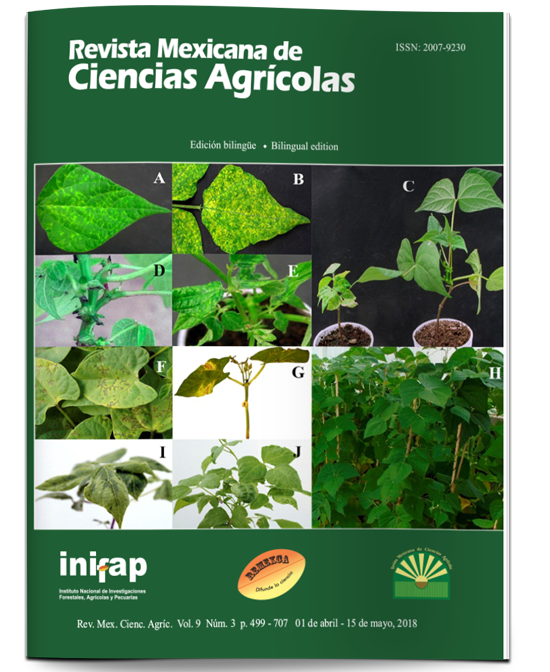Chemical treatment of corn seed for control of trips (Frankliniella occidentalis) Pergande (Thysanoptera:Thripidae)
DOI:
https://doi.org/10.29312/remexca.v9i3.1215Keywords:
Zea mays L., Frankliniella occidentalis, Pergande, Thysanoptera: ThripidaeAbstract
The objective of the present investigation was to evaluate the chemical control of trips Frankliniella occidentalis Pergande (Thysanoptera:Thripidae) with the application of four seed products (thiodicarb, acephato, bifenthrin + imidacloprid and thiametoxan + lambda cyalotrina) with two doses; one according to the dosage of the commercial house and the other 50% smaller, in the variety Roque 1. A randomized block design with four repetitions, 10 treatments and two controls, a hybrid (Ares®-Unisem) was used and a white one. The sampling of the density of trips was carried out by means of a manual aspirator and blue traps, the samplings were made from the emergence of the plants and during eight weeks, carrying out two samplings per week. The results show that the treatment with thiamethoxane + lambda cyalotrine presented the lowest density of trips with a value of 1.53 trips per plant, while the absolute control was the one with the highest value with 2.14.
Downloads
Published
How to Cite
Issue
Section
License
The authors who publish in Revista Mexicana de Ciencias Agrícolas accept the following conditions:
In accordance with copyright laws, Revista Mexicana de Ciencias Agrícolas recognizes and respects the authors’ moral right and ownership of property rights which will be transferred to the journal for dissemination in open access. Invariably, all the authors have to sign a letter of transfer of property rights and of originality of the article to Instituto Nacional de Investigaciones Forestales, Agrícolas y Pecuarias (INIFAP) [National Institute of Forestry, Agricultural and Livestock Research]. The author(s) must pay a fee for the reception of articles before proceeding to editorial review.
All the texts published by Revista Mexicana de Ciencias Agrícolas —with no exception— are distributed under a Creative Commons License Attribution-NonCommercial 4.0 International (CC BY-NC 4.0), which allows third parties to use the publication as long as the work’s authorship and its first publication in this journal are mentioned.
The author(s) can enter into independent and additional contractual agreements for the nonexclusive distribution of the version of the article published in Revista Mexicana de Ciencias Agrícolas (for example include it into an institutional repository or publish it in a book) as long as it is clearly and explicitly indicated that the work was published for the first time in Revista Mexicana de Ciencias Agrícolas.
For all the above, the authors shall send the Letter-transfer of Property Rights for the first publication duly filled in and signed by the author(s). This form must be sent as a PDF file to: revista_atm@yahoo.com.mx; cienciasagricola@inifap.gob.mx; remexca2017@gmail.
This work is licensed under a Creative Commons Attribution-Noncommercial 4.0 International license.



